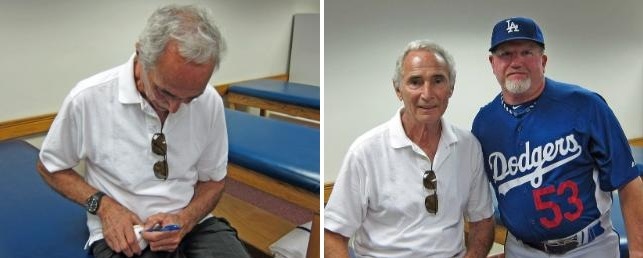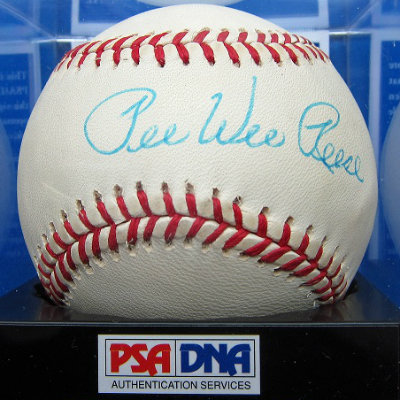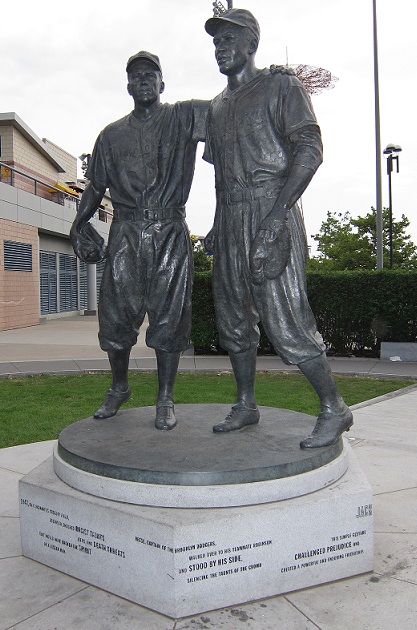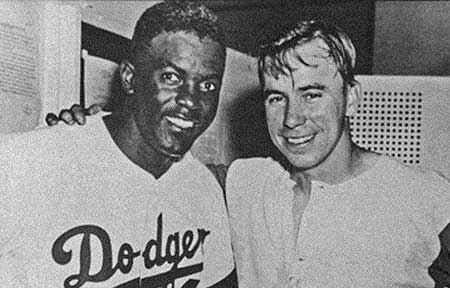It’s true – I am an autographed baseball junkie. In most cases, it’s the thrill of the hunt and then the adrenaline rush when the player whose autograph I am seeking finally signs that ball and hands it back to me (or tosses it back to me at my home away from home in the Left Field Pavilion at Dodger Stadium).
For me, my greatest autograph moment came on Thursday, November 10, 2011 at LAD Adult Baseball Camp in Vero Beach, Florida when the ghost himself showed up in camp and signed a ball for me as I trembled and thanked him profusely for providing me with some of my greatest childhood memories. The man signing the ball was, of course, the greatest left-hander to ever play the game, Sandy Koufax.

I was in absolute awe to finally meet my childhood (and life-long) Dodger hero. It truly was a fantasy come true.
(Photo credit – Ron Cervenka)
Over the years, I have been very blessed to get many other autographed baseballs, some from former legends of the game and many more from young players hoping to someday become legends of the game. In addition to the baseballs that I have personally gotten signed, I have maybe a dozen or so autographed baseballs that I purchased on eBay or from the many memorabilia shops on Main Street in Cooperstown, New York. Why buy them you ask? Well, putting it bluntly, their authors have moved on to that great baseball diamond in the sky, that’s why.
About a week ago and as I occasionally do from time to time; I decided to surf around on eBay to see if there was anything interesting which, of course, there always is. I had absolutely no intention of buying anything which, of course, I never do, but I usually end up bidding on something. Just for the heck of it, I started looking through some autographed baseballs that were up for auction… and I got bit – right square in the heart, I got bit.
Staring back at me through my computer monitor was an absolutely beautiful baseball autographed by one of the greatest men to ever play the game. You’ll notice that I didn’t say one of the greatest players to ever play the game; I said one of the greatest men to ever play the game. Oh sure, he’s a Hall of Famer and his uniform number is hanging above that very home away from home of mine, but this man is better known for giving baseball its finest moment. His name was Harold Peter Henry Reese, but to everyone in the world, he will always be known as Pee Wee Reese.
As luck would have it, I was once again blessed and won the auction for this beautiful baseball (and for a great price) and I was on pins and needles until it arrived. After a few quick photographs of it, I placed it in my autographed baseball display right next to several of Pee Wee’s former teammates including Koufax, Duke Snider, Don Newcombe, Carl Erskine, Don Drysdale, and Johnny Podres.

It was quite an honor to add Pee Wee Reese’s autographed baseball to the other ‘Boys of Summer’ autographed baseballs in my collection. (Photo credit – Ron Cervenka)
Finding myself frequently looking over at this latest addition to my collection, I decided to do a little on-line reading about Pee Wee Reese, something that I have done quite a few times in the past with him and with many other Dodger greats. In doing so, I came across a Pee Wee Reese story that I was quite familiar with, but it was told in far more detail than previous versions I had read. It is, of course, the story about newly acquired Dodger Jackie Robinson’s first road trip to Cincinnati in May of 1947. Although there are a couple different variations of the story (as to whether it happened during pre-game infield practice or during the actual game), the gist of the story has never been questioned. Amidst a barrage of vicious racial slurs and obscenities (from Reds players and fans), Reese calmly walked over to Jackie and put his arm around Jackie’s shoulders, which immediately silenced the crowd. So significant was this moment in baseball history that years later, noted sculptor William Behrends created a beautiful statue of the event which was unveiled and dedicated on November 1, 2005 in front of (then) Key Span Park (now MCU Stadium) in the Coney Island district of Brooklyn, New York – home of minor league baseball’s Brooklyn Cyclones.

This statue located in Brooklyn, New York is a representation of what is arguably baseball’s finest moment. (Photo credit – Ron Cervenka)
Rather than retell this story in my own words, I will instead re-post the article verbatim as told by its original author Bob Herbert, who is an Op-Ed columnist for The New York Times. Herbert originally posted the article on September 23, 2005 and it is perhaps one of the best Pee Wee Reese articles I have ever read. Here again, this is entirely the work of Bob Herbert and I am in no way plagiarizing his great work – it is simply too great of a story not to share or to be forgotten.
* * * * * * * * * *
Baseball’s Finest Moment: Pee Wee Reese
In the spring of 1947, when it became widely known that the Brooklyn Dodgers were about to bring Jackie Robinson up from their Montreal farm club, a group of players on the Dodgers began circulating a petition. One of the players who was asked to sign was Pee Wee Reese.
The writer Roger Kahn, who would later become close to Reese, told me a few years ago that the petition said, in essence, “If you bring up the nigger, trade us. We won’t play.”
Reese, the team’s shortstop had grown up in the Jim Crow atmosphere of Louisville, Ky., and had never so much as shaken hands with a black person. He was considered a lock to sign. But he wouldn’t. He didn’t make a big deal out of it. He just refused to sign. The petition died.
When the Dodgers brought Robinson up a short time later, they put him at first base. (Eventually he would play second.) As is now well known, the abuse he took as the first black player in the modern era of the major leagues was grotesque. Pitchers ignored the strike zone and threw directly at his head. Base runners tried to gouge him with their metal spikes. People spat at him, threw garbage at him, and shouted every disgusting epithet imaginable.
In his book, “The Boys of Summer,” Kahn noted that the sportswriter Jimmy Cannon spent a day with the Dodgers in 1947 and concluded that “Robinson is the loneliest man I have ever seen in sports.”
One day, in Cincinnati, when the abuse had reached a fever pitch, Reese decided he had had enough. The Dodgers were on the field and the players in the Reds’ dugout were shouting obscenities at Robinson. Fans were booing and cursing Robinson, who was standing at first and trying, amid the chaos and the rising heat of his own anger, to concentrate on the game.
Reese called time. And in a gesture that is deservedly famous, he walked across the infield to Robinson, placed a hand on his shoulder in a very public display of friendship, and offered him a few words of encouragement.
“It gets my vote,” said Kahn, “as baseball’s finest moment.”
Reese and Robinson eventually became very close. So close, in fact, that Reese could needle the high-strung Robinson in ways that others didn’t dare try. Robinson was often difficult to get along with, and Reese once told him, “You know, Jack, some of these guys are throwing at you because you’re black. But others are doing it because they just don’t like you.”
Kahn remembered another time when someone had threatened to shoot Robinson if he played in an exhibition game at Atlanta. Reese sidled over, in the midst of tremendous tension, and said, “Do me a favor, Jack.” Robinson said, “Yeah, what?” Reese said, “Don’t stand too close to me. We don’t know what kind of shot this guy is.”
When Jackie Robinson died in 1972, he was just 53 years old. Pee Wee Reese, teammate and friend, was one of the pallbearers at his funeral. Reese died of lung cancer in 1999. He was 81.
(Photo credit: The photo was taken by The Associated Press of Pee Wee Reese, left, and Jackie Robinson in the clubhouse after the Dodgers beat the Yankees, 5-3, in the third game of the 1952 World Series.)




 December 30th, 2012 at 4:45 am
December 30th, 2012 at 4:45 am  by Ron Cervenka
by Ron Cervenka 

 Posted in
Posted in 

I knew this one was coming and it is a story that can be told over and over and never get worn out. Great reminder Ron and Bob.
I am a huge Jackie Robinson fan and although Duke was my favorite player, Jackie is the man I respected most in all of MLB during my lifetime. My admiration for Pee Wee is right up there.
There can be little wonder why #1 is retired. Pee Wee was undoubtedly the greatest leader the Dodgers have had as a captain. It was written that he played the three most difficult positions in baseball – captain, lead off and shortstop – one as a leader of men, the other two on the field.
When a sportswriter asked Pee Wee if he was threatened by Robinson taking his position of shortstop, he simply responded, “If he can take my job, he’s entitled to it.” That about says it all about the Little Colonel.
Very nice! After opening my gift on Christmas morning and showing everybody my brand new vintage “42” jersey, you can imagine my dismay when nobody else in the room reacted the way I did. In fact it was a sense of rather nonchalance. Like it was just another jersey! My response was that of bewilderment, asking everybody in the room “do you not know who’s number this is? Do you not know who wore this jersey? Do you not know the historical significance of what I am holding in my hands????” Needless to say there were no other baseball fans sitting in the same room as I. That was one moment I truly wish I had some of my TBLA friends amongst me, to celebrate such a great moment with me. And I too would have liked to be with you 53 upon opening your Pee Wee ball. Congratulations bro!!
I too recieved a 1955 Jackie Robinson Brooklyn Dodger jersey for Christmas, and yes other than my wife, who bought me the jersey (and I know everyone here on TBLA understands) no one understood my excitment. They too thought it’s just another Jersey. I have two young nieces who I want to tell them the stories of Jackie Robinson, and the Dodgers, but they seem to have no interest. It kinda breaks my heart.
The story of Pee Wee Reese and Jackie Robinson never gets old. I am very excited for the movie “42” to come out in April. I will be there at the first showing.
The signature is clean. Nice piece for your collection. Congratulations!
Ron, I have had bad luck with getting balls signed, the all seem to fade. Any tips?
Evan – You have mail.
The statue at MCU stadium is a brilliant reminder of what took place that day in Cincinatti and it will always be there for the fans in future generations.
One of the best stories in all of Baseball !! Thank you for sharing Ron and congratulations on the ball !!
[…] from https://thinkbluela.com/2012/12/baseballs-finest-moment/ on May 23, […]